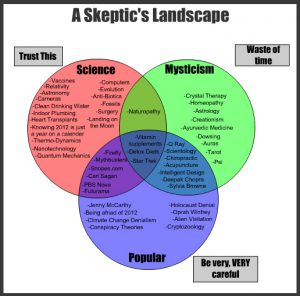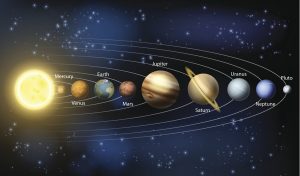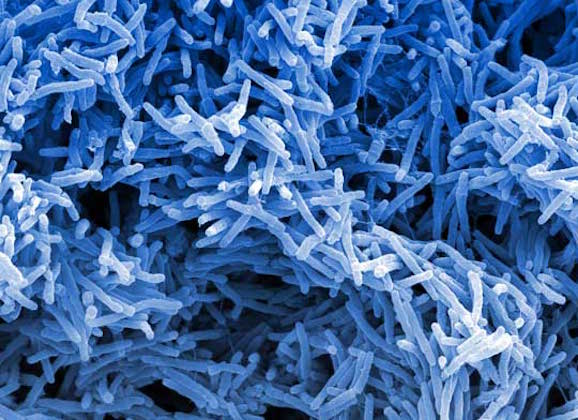Homeopathy Put Into Perspective
Last week, I was discussing various forms of alternative medicine with some colleagues over lunch, and figured that I should write a blog post about a popular branch of alternative medicine that’s been getting lots of attention in the media: homeopathy.
First, let’s start with a brief introduction: alternative medicine is a practice that is described as having similar effects to medicine, but does not follow the scientific method, makes claims that can’t be tested or reproduced, lacks research to back up the claims it makes, or is contradicted by findings already made in science. Alternative medicine includes practices such as naturopathy, homeopathy, and crystal healing.
Due to the lack of evidence behind alternative medicine, and the continuously mounting evidence for its non-effectiveness, it is denounced by the medical community. Many forms of alternative medicine have been tested for effectiveness, and have been shown to be no more useful than placebos.
For this post, I’m going to focus on homeopathy. Other alternative medical branches are better left for another blog post.
Homeopathy (which, in Greek, translates to ‘same suffering’) is centered on the belief of ‘like cures like’, meaning that a substance that makes a healthy person ill will be able to cure someone who is suffering from the same disease. An example of this is: using a cat’s hair to cure a cat allergy.
In order to cure someone, homeopathy states that the substance must be highly diluted in water before taking it. Their reason for this is centered around the idea that water is able to retain the memory of substances it’s previously been in contact with, and therefore is able to still carry out the actions of the medicine that’s been diluted into it.
Based on the previous paragraph, you might ask: “If water has memory, why doesn’t it retain the properties of all the other stuff it’s come into contact with, such as minerals, bacteria, and likely human waste?” The solution is simple: the idea of water memory is nonsense. It hasn’t been proven in science at all, and if it did exist, we would have discovered it long ago.
Homeopaths also believe that dilution increases potency, because increasing dilution will increase the amount of memory that the water has. This is also completely contrary to science: dilution doesn’t increase potency. It decreases it because you have less of the original substance which is successive dilution.
Now, at first guess, you’d probably say that ‘highly diluted’ would be 1 part of substance in 100 parts of water, or maybe even 1 part of substance in 1000 parts of water, right? Nuh-uh. We’re going much, much, more diluted than that.
Homeopathic remedies are typically diluted so excessively that NO molecules of the original substance are present in the actual remedy. Essentially, this means that if you purchase a homeopathic remedy from the drugstore, you will be buying nothing but pills of lactic acid and water, which makes it no different from placebos used in drug trials. I encourage you to watch CBC’s Marketplace special on homeopathy, where they demonstrate that even the most sophisticated analytical instruments can’t detect any medicine in a homeopathic pill. What they did detect in the pills, though, was sugar.
These remedies can range in dilutions from 1 molecule of substance in 1,000,000,000,000,000,000,000,000,000,000 molecules of water, and can even go up to a 1/10^400 dilution, which is one molecule of substance for every 10,000,000,000,000,000,000,000,000,000,000,000,000,000,000,000,000,000,000,
000,000,000,000,000,000,000,000,000,000,000,000,000,000,000,000,000,000,
000,000,000,000,000,000,000,000,000,000,000,000,000,000,000,000,000,000,
000,000,000,000,000,000,000,000,000,000,000,000,000,000,000,000,000,000,
000,000,000,000,000,000,000,000,000,000,000,000,000,000,000,000,000,000,
000,000,000,000,000,000,000,000,000,000,000,000,000,000,000,000,000,000,
000,000,000,000,000,000,000,000,000,000,000,000,000,000,000,000,000,000,
000,000,000,000,000,000,000 molecules of water. That’s what I call dilute.
It’s tough to get an appreciation for how large of a number this is unless it’s made a little easier, so I did some number crunching to give this analogy.
1/10^400 is equivalent to taking one grain of rice, crushing to a powder and dissolving it in a sphere of water the size of the Solar System, with the Sun at the center and the orbit of Pluto at the outside (giving this sphere a radius of 3.67 billion miles), and then repeating that process 8 more times in a series. Now, if that isn’t dilute, I don’t know what is.
Alternatively, you could take a mixture containing every single atom in the observable Universe, dissolve one molecule of medicine in it, and then repeat that dilution four more times in a series.
Hilarity aside, the Australian National Health and and Medical Research Council conducted a meta-analysis of studies on homeopathy. They looked at 1,800 papers about homeopathy’s effectiveness and found no evidence that it is effective. Again, this makes sense. The claims made by homeopathy don’t stand up in science at all, and go against decades of research and, often, common sense.
Should these pills be sold as medicine? Absolutely not. There’s nothing in them. However, homeopathic remedies are sold in pharmacies across the world. In the United States, Americans have spent 3 billion dollars on homeopathic remedies. This is a scary fact.
An even scarier fact is that some homeopaths are selling homeopathic vaccines as an alternative to conventional vaccines for polio, whooping cough, and measles, among other vaccines. For a homeopath to sell a pill with nothing in it, and claim that it has the ability to protect you from a serious disease, is very problematic. It may end up tricking parents into giving their child something described by their homeopath to be just as effective as a conventional vaccine, but in reality has no protective effect at all.
When all of this is put into perspective, it is very scary. I’m giving the facts on this whole scenario to make sure that people understand what homeopathy is all about, and so they don’t get scammed. It is something that has no business being available in a pharmacy.






Dear Trevor Henderson,
Greetings!
Please try a homeopathic medicine, say Lapis alba 200 C for 1 week, that would be best way to see if you get any symptoms/effects of medicine or not. Ridiculing a system of treatment on the basis of shallow knowledge is not appreciated. I was one among the people who opposed homeopathy but learnt its effect by way of experimenting not on literature. Given a chance I can prove my point. Let me know if you/your team would be travelling to India, some time. For your information Dr. Hahnemann was an Allopath then turned to Homeopathy and please read the basis of vaccination (both live and attenuated) its actually the same concept which homeopathy utilizes, not the memory of water as stated by you.
Thanks and regards,
Dr. Balbir
Hi, Dr. Singh.
Thanks for taking the time to read my blog post. I respect your opinion on this matter, but I am simply stating the facts about homeopathy. I don’t believe that I have a shallow knowledge on this matter, as I had to do extensive research on homeopathy’s origins and principles while writing this post.
While it is true that Samuel Hahnemann was originally an allopathic doctor, medicine in the 18th century was very different from medicine that is practiced today. Today, medicine is looked at as both an art and a science, but back in the 18th century, medicine was essentially an art: there was very little science behind it (with a few exceptions, such as Edward Jenner’s smallpox experiments). Physicians back then would practice procedures such as bloodletting (where a patient is bled severely in an attempt to remove disease) and blistering (which was used in an attempt to treat insanity), both of which we now know have no benefit.
Samuel Hahnemann was unhappy with the current state of medicine when he was practicing, and actually gave up his practice before discovering homeopathy. He came up with the idea of ‘like cures like’ when testing a potential remedy for malaria on himself, which he noticed also created malaria-like symptoms when he ingested them.
This led Hahnemann to further experiment with other compounds. Unfortunately, these compounds were very toxic when ingested, which is why they created similar symptoms in healthy people when compared to the people with the disease. Since these substances were very toxic, Hahnemann hypothesized that diluting the toxin heavily and shaking it vigorously would still provide some effect, while preventing any severe poisoning of the patient.
Now, the problem here is that the dilutions are so high that more often than not, there are no molecules of the original substance left. This is one of the reasons why homeopathy is under criticism by the scientific community, and one of the reasons why I wrote this blog post.
If you take this principle and apply it to a regular OTC medication like Aspirin, what would happen? If I diluted an Aspirin to 1/10^400, would it have any effect? No, because there wouldn’t be any molecules of Aspirin left in the solution, and therefore Aspirin’s target enzyme (cyclooxygenase, or COX) would remain uninhibited.
With regards to the medication you mentioned: I don’t know what Lapis alba is, but I know that a 200C dilution in homeopathy is the 1/10^400 dilution that I mentioned in my blog post. This is a dilution so large that a homeopathic preparation with that magnitude of dilution would have no molecules of Lapis alba remaining in the solution, so how would it be possible for it to have any therapeutic effect?
In response to your experimenting vs literature on homeopathy: as a scientist or a physician, we read scientific literature in order to assess whether an avenue of research is worth pursuing.
For example: if I want to design a drug that targets a cell cycle protein for the treatment of breast cancer, I should search through previous research on this protein and examine any literature on it to see whether this protein has been shown to play a role in the progression of breast cancer.
There is mountains of literature (1800 papers, as I mentioned) that demonstrates that homeopathy is ineffective, and I encourage you to read the report that was published by the Australian Government’s NHMRC (https://www.nhmrc.gov.au/_files_nhmrc/publications/attachments/cam02_nhmrc_statement_homeopathy.pdf). Therefore, as a logicial-thinking scientist, it is safe to assume that homeopathy does not have effectiveness comparable to conventional medicine, due to the large amount of evidence that scientists have produced.
Homeopathy and vaccines do not use the same concept. As we all know, homeopathy is based on the idea of ‘like cures like’ and uses hyper-diluted solutions. Vaccines, on the other hand, are not hyperdiluted, are used as a prophylactic, and have eradicated multiple diseases such as polio and smallpox, saving millions of lives in the process.
If, as you claim, homeopathy and vaccines use the same basis, why hasn’t homeopathy eradicated any diseases? It’s because homeopathy and vaccines are two entirely different things.
To illustrate this, let’s apply homeopathic principles to vaccines: if a vaccine was hyper-diluted, it would be unable to stimulate the immune system to produce antibodies, because there would be none of the original antigen left. This would effectively make the vaccine useless.
I appreciate your comments, respect your opinions on homeopathy, and thank you for taking the time to read my blog post.
Best regards,
Trev
Respect respect respect!
Dear Trev,
Happy to see that UVIC placed my comments/opinions without any bias. At the same time, nice to hear from you. We may differ in the opinions but its important how we place our views, accept my sincere regards.
Coming to homeopathy…
1. There are doses known as mother tincture (Q) which are not hyperdiluted. It is not about the memory of water molecules.
2. NHMRC report was basically an assessment based on an overview of published systematic reviews.
3. NHMRC did not consider observational studies, individual experiences and testimonials, case series and reports.
4. Pls. note that out of a total of 343 articles submitted to NHMRC, majority (234) were not considered owing to the inclusion criteria.
5. One would be surprised to see that the Homeopathy Working Committee included not even a single Homeopath but yes ..it had many Allopaths.
6. Finally, regarding the efficacy of highly diluted medicines I have already mentioned- try it your self….take Lapis alba 200 C for 1 week or Ten days by way of experiment. No chances of harm, as you say it can’t have any effect.
I am sharing my email id… I personally feel it would be difficult to prove the point over here. We can discuss. balbirahs@gmail.com.
Thanks again.
Regards,
Dr. Balbir
Hi, Dr. Singh.
Thanks for the comments. It is nice to hear from you, too. I agree that it’s important to discuss with others who may have differing opinions, and I am happy to do so. I’m going to answer your points in the same format as you put them.
1. Mother tinctures indeed exist, but they are the solution from which homeopathic dilutions are prepared. I was unable to find any evidence of mother tinctures being used for therapeutic benefit, and the reason for this is that most homeopathic compounds are usually very toxic when not diluted.
2. The NHMRC did not do an assessment, they did a massive review of meta-analyses, reviews, and studies. This is done repeatedly in the scientific and medical community to assess whether something is effective or not. An excellent example of this is the Cochrane Foundation study in 1989, which conducted a massive review of studies regarding the use of corticosteroids for women who go into labour early, as several studies had varying conclusions. By analyzing all the studies conducted on this topic, all of which had slightly or drastically different conclusions, a reliable final conclusion was able to be made.
This is very, very, important in science. One study does not necessarily equal truth, as there are many variables that must be taken into account. This is why two separate studies looking at the same topic can end up with varying results.
3. In a drug trial, individual experiences and testimonies are for the most part meaningless when looking at a drug’s effectiveness as they are not quantitative. They are useful for knowing the side-effects such as nausea and dizziness, but isn’t able to tell us whether the drug is doing what it’s supposed to do.
For example: if I’m running a drug trial for a hypertension medication, and one of the patients says to me ‘I feel better’, is that enough evidence for the medicine’s effectiveness? Absolutely not. The patient must have a quantitative variable that can be measured (in this case, blood pressure) to demonstrate effectiveness.
Case series were not included as they are usually used to suggest new avenues of research and seldom will look for quantifiable data. If you review the criteria for consideration into this report, you’ll notice that case studies don’t fit in anywhere. As for reports, I’m not too sure what you mean by that, as it is a very ambiguous word in science, but if they weren’t included, it’s because they did not meet the very strict and necessary required for this review.
4. It’s true that 243 studies were not included in the NHMRC’s review. The reason for this is because the NHMRC had very strict regulations with regards to what sort of review/meta-analysis/study could be included. To quote the NHMRC: “Studies that were not systematic reviews, meta-analyses or prospectively designed and controlled studies (including randomised controlled trials, pseudo-randomised controlled trials, non-randomised controlled trials and prospective cohort studies) were excluded. Editorials, comments, book chapters, animal studies, correspondence, and news items were excluded. Studies were also excluded if they were not reported in full (e.g. research or systematic review protocols, conference proceedings, articles published in abstract form)”.
Essentially, the NHMRC took very strict precautions to ensure that the data they analyzed was sound and obtained properly. They did not purposely exclude certain studies to obtain the result they wanted, they excluded submissions that were not reliable. Therefore, you can expect the results that the NHMRC produced to be very, very, reliable.
5. While it is true that the committee was comprised entirely of physicians, it should also be noted that these members of the committee are also experts on evidence-based medicine and study design. This is essential for this review to succeed, because it ensures that those who are reviewing the data given for this review are able to properly interpret it and come to a reliable conclusion. If the members of the committee were laymen, they would not be able to come to a reasonable conclusion based on the data used in this review, because they’d have no idea what they were doing.
It is also true that there are no homeopaths on the committee, if you read a little closer into the committee, all of the members are experts on complementary/alternative medicine research (homeopathy falls into this category).
It can be argued that not having a homeopath on the committee causes a bias, but here’s an interesting tidbit of information: according to the Australian Homeopaths Association, ‘homeopath’ isn’t a protected term in Australia and many other parts of the World. This means that anyone can call themselves a homeopath, because, after all, all they are doing is selling hyperdiluted samples. In contrast, no one is legally allowed to call themselves a ‘doctor’ until they obtain a medical degree from an accredited institution.
This puts it into perspective, as an ideal committee for a study of this magnitude would have to be comprised of experts. However, if anyone in Australia can call themselves a homeopath, it is better to have a committee comprised of medical experts, all of whom have an extensive knowledge of alternative medicine, because that way you’ll know that your committee is qualified.
6. I don’t know what Lapis abla is, and I can’t find any information about it on regular chemical inventory sites. This is odd, because if this ‘Lapis alba’ is a medicine or a compound, I should be able to find at least a little bit of information about it somewhere on the Web. The only place on the web where I can find information on ‘Lapis alba’ is homeopathic websites, who describe it as ‘silicofluoride of calcium’. This sounds like a chemical, but I can’t find ANY information about it on accredited chemical websites: no structure, no safety information, no toxicological information, no formula, nothing. If I can’t find any information about the compound, then this sets up red flags and makes me wonder what it actually is. If I was a physician, would I feel comfortable giving my patient a solution of a compound for which there was NO toxicological/biochemical information? Absolutely not.
Again, you mention the 200C dilution. As you know, this is the 1/10^400 dilution that I’ve mentioned a few times before. 10^400 is a number so large that you can’t really get an appreciation for it unless it’s put into layman’s terms, no matter how scientific you are.
A 10^400 dilution is roughly equivalent to taking a single proton (a subatomic particle with a volume of 2.82 x 10⁻⁴⁵ m³) and dissolving it in a sphere of water the size of the Milky Way Galaxy (giving this sphere a radius of 300,000 trillion miles), and then repeating that process three more times in a serial dilution.
This underlines my point about homeopathy having no molecules of the original substance present: the dilutions are so unfathomably large that they can’t, by any biological or chemical sense, have an effect. It’s true that no harm would come to me if I took a 200C homeopathic remedy, because there’s no original substance present, only water and sugar.
Thanks for your comments and for taking the time to read my first response.
Kind regards,
Trev
There’s a good video where James Randi takes a bottle of homeopathic ‘meds’ and eats the entire contents. The bottle warns not to take more than 3 pills.
He has done this dozens of times at his shows. Nothing happens, because it’s just sugar water.
Homeopathy is not alone in having a nonsensical basis yet being believed by many people, including intelligent people. Astrology, crystal power, Tarot Cards, and UFOs are just a few other popular New Age beliefs.
Some of these belief systems go out of fashion and disappear almost completely, such as pyramid power and phrenology. But that doesn’t deter believers in nonsense, who rely on inconclusive scientific research or the placebo effect when they need to defend their beliefs.
It is worth pointing out that our beliefs, even when false, are actually useful in maintaining our ego, which keeps us stable as our constant seeking for peace and happiness fails again and again.
The fundamental problem is that we live in times of great stress and strain in the family, in society, and in the entire world. Some of our responses to inheriting that stress are noble, and some are horrible. People can kill others and delay necessary medical treatment because of their arbitrary beliefs.
Until we get on a truly effective path of self-improvement, which includes the elimination of the dysfunctions of the nervous system resulting from our stressful environment, we do the best we can.
All I can say is, something better exists, so keep searching until you find it. Meanwhile, tolerate the beliefs of others as best you can, while upholding scientific and experiential truth wherever possible.